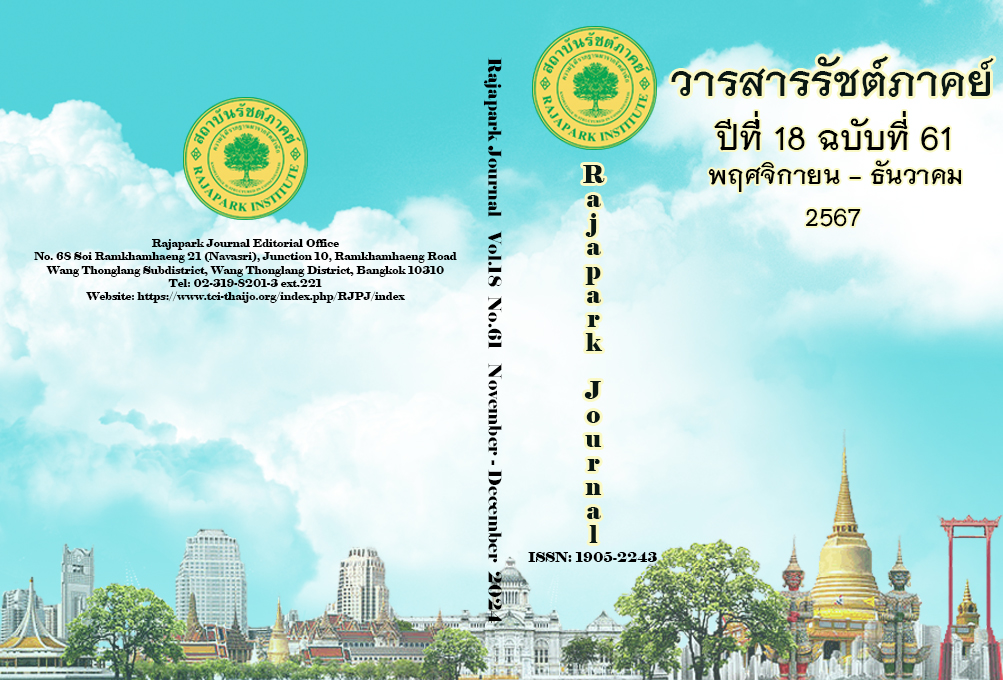The “Nattaya-Alangkarn” Performing Arts Promotion Products by the Community, Based on the Cultural Heritage of Thai Western Ethnicity
Main Article Content
Abstract
The study aims to explore and analyze the cultural capital of communities for product design and development and to assess satisfaction with promotional products related to the "Nattaya-Alangkarn" performing arts, based on the ethnic cultural heritage of the western region. The research process involved: (1) conducting fieldwork in ethnic communities to gather information on community identity, cultural capital, and needs; (2) compiling and validating the collected data with community representatives; (3) designing product prototypes based on community identity and refining them with representatives; (4) making final adjustments prior to implementation; and (5) evaluating tourist satisfaction with the aesthetics of the products. The sample size was determined using the n4Studies software, resulting in a sample group of 319 participants. The findings, derived from an analysis of cultural capital leading the development of four products: the Tai Dam Bag, Watermelon-Patterned Sarong, Karen Shirt, and Silver Jewelry. Satisfaction with these promotional products supporting the "Nattaya-Alangkarn" performing arts was highest for the Tai Dam Bag, Watermelon-Patterned Sarong, and Karen Shirt in terms of usability and practicality, with average scores of 4.87, 4.93, and 4.90 (S.D. = 0.34, 0.36, and 0.29), respectively. For the silver jewelry, the highest rating was for the appropriateness of the design materials, with an average score of 4.89 (S.D. = 0.30). These product designs successfully incorporated local identity into the aesthetic of performance costumes, reflecting the ethnic cultural identity of the communities in the western region.
Article Details

This work is licensed under a Creative Commons Attribution-NonCommercial-NoDerivatives 4.0 International License.
Views and opinions appearing in the Journal it is the responsibility of the author of the article, and does not constitute the view and responsibility of the editorial team.
References
Chatnuntaphorn, P. (2024). Study and development of souvenirs at community tourism spots according to The Kui cultural identity of Ban Rong Ra Prangku District, Sisaket Province. Journal of Humanities and Social Sciences (JHUSOC), 22(1), 40-59. https://so03.tci-thaijo.org/index.php/jhusoc/article/view/273566
Chenayotin, C. (2008). Thai Zong community of Donsai, Nakhon Pathom Province: the study of economic development, A.D. 1961-2006[Master’s thesis, Silpakorn University]. https://sure.su.ac.th/xmlui/handle/123456789/11672
Chiang Mai News. (2017, Sep 8). Raising standards: Thai wisdom products. https://www.chiangmainews.co.th/
Jenjai, N. (2023). Community product development from cultural wisdom capital, the old town Sob Som-Hat Krai community, Wiang Sub-district, Chiang Khong District, Chiang Rai Province. Journal of SaengKhomKham Buddhist Studies, 8(3), 559-579. https://so02.tci-thaijo.org/index.php/jsbs/article/view/260728
Inchan, D. (2019). Karen ethnic community dynamics in western Thailand, Phase 1, study area of Kanchanaburi, Ratchaburi, and Phetchaburi provinces, National Community Dynamics Research Project Series. Species for creating living culture maps, Year 1 (2019). Silpakorn University. http://sac-research.sac.or.th/research-item-search.php?ob_id=237
Lerttevasiri, P. (2004). Design education 2: A collection of academic and research articles on Design. Chulalongkorn University.
Ministry of Higher Education, Science, Research and Innovation, Thaoland. (2021, May 3). Annual report 2020. https://www.mhesi.go.th/index.php/content_page/item/3548-2563-annual-report-2020.html
Na Thalang, E. (2001). Folk wisdom and the learning and adaptation process of Thai villagers. Amarin.
Patmasiriwat, D. (2004). Social capital and cultural capital, economy and management in the new era. Faculty of Management Science and Information Science, Naresuan University.
Ploynutkasem, D., & Suwannatat, P. (2021). Graphic design on package using Ionian mode of music theory, diatonic modes. NRRU Community Research Journal, 15(3), 131-143. https://so04.tci-thaijo.org/index.php/NRRU/article/view/245606
Rojwatham, S. (1999), Homestay tourism: how does it affect the way of life of the Thai Song Dam people? case study: Thai Song Dam people, Village No. 5, Khao Yoi Subdistrict, Khao Yoi District, Phetchaburi Province[Master’s thesis, Silpakorn University]. https://sure.su.ac.th/xmlui/handle/123456789/2985
Rojanahutsadin, N., & Pecharanond, T. (2019). Healthy food package image database system with a cross-cultural “Kansei” search function. Faculty of Science, Chulalongkorn University. http://cuir.car.chula.ac.th/handle/123456789/78446
Saithong, Y. (2019). Research and development of home decorative design mixing with metal hardwares from lead free nielloware technique. Institute of Culture and Arts Journal, Srinakharinwirot University, 7(2), 102-118. https://so02.tci-thaijo.org/index.php/jica/article/view/121755
Seo, M., & Khiaomang, K. (2019). The study on the creation of color identity for packaging design of Chonburi district, Chonburi province. Journal of Industrial Education, 18(1), 45–57. https://ph01.tci-thaijo.org/index.php/JIE/article/view/149366
Sunthornwat, A. (2008). Karen dance of Suan Phueng District. Phetkasem Printing Group.
Tangcharoen, W. (1996). Design. Odean Store.
The Fine Art Department. (1991). Ratchaburi. Amarin.
The Sustainable Arts and Crafts Institute of Thailand (Public Organization). (2020). Arts and Crafts Teacher. https://www.sacit.or.th/th/listitem/1106
Tohpanurakkul, A. (2015). Participatory action research in the conservation and transmission of Thai Song Dam weaving wisdom[Doctoral dissertation, Silpakorn University].
Wayne, W. D. (1995). Biostatistics: A foundation of analysis in the health sciences (6th ed.). John Wiley & Sons.
Wiwitkulkasem, R., & Chaiuppala, S. (2017). The development of souvenirs to represent the Luang Prabang local identity. Asian Creative Architecture, Art and Design, 24(1), 65–77. https://so04.tci-thaijo.org/index.php/archkmitl/article/view/92379
Yawilakad, A., & Po-Ngern, W. (2019). A study of art learning achievements on the topic of composition and creative ability of grade 4 students, using art activities based on the six thinking hats concept together with visual art analysis. Journal of Educational Measurement, Mahasarakham University, 25(1), 287-301. https://so02.tci-thaijo.org/index.php/jemmsu/article/view/199158


